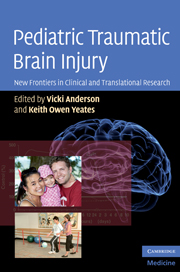Book contents
- Frontmatter
- Contents
- List of contributors
- Acknowledgments
- Introduction: Pediatric traumatic brain injury: New frontiers in clinical and translational research
- 1 Biomechanics of pediatric TBI
- 2 Neurobiology of TBI sustained during development
- 3 Using serum biomarkers to diagnose, assess, treat, and predict outcome after pediatric TBI
- 4 Clinical trials for pediatric TBI
- 5 Advanced neuroimaging techniques in children with traumatic brain injury
- 6 Neurobehavioral outcomes of pediatric mild traumatic brain injury
- 7 Very long-term neuropsychological and behavioral consequences of mild and complicated mild TBI: increased impact of pediatric versus adult TBI
- 8 Neurobehavioral outcomes of pediatric traumatic brain injury
- 9 Neuropsychological rehabilitation in children with traumatic brain injuries
- 10 Psychosocial interventions
- 11 Pediatric TBI: challenges for treatment and rehabilitation
- 12 Integrating multidisciplinary research for translation from the laboratory to the clinic
- Index
- Plate section
- References
5 - Advanced neuroimaging techniques in children with traumatic brain injury
Published online by Cambridge University Press: 14 May 2010
- Frontmatter
- Contents
- List of contributors
- Acknowledgments
- Introduction: Pediatric traumatic brain injury: New frontiers in clinical and translational research
- 1 Biomechanics of pediatric TBI
- 2 Neurobiology of TBI sustained during development
- 3 Using serum biomarkers to diagnose, assess, treat, and predict outcome after pediatric TBI
- 4 Clinical trials for pediatric TBI
- 5 Advanced neuroimaging techniques in children with traumatic brain injury
- 6 Neurobehavioral outcomes of pediatric mild traumatic brain injury
- 7 Very long-term neuropsychological and behavioral consequences of mild and complicated mild TBI: increased impact of pediatric versus adult TBI
- 8 Neurobehavioral outcomes of pediatric traumatic brain injury
- 9 Neuropsychological rehabilitation in children with traumatic brain injuries
- 10 Psychosocial interventions
- 11 Pediatric TBI: challenges for treatment and rehabilitation
- 12 Integrating multidisciplinary research for translation from the laboratory to the clinic
- Index
- Plate section
- References
Summary
Pediatric traumatic brain injury remains a major public health problem. Fortunately, the advent of several neuroimaging techniques has improved our ability to better diagnose and treat affected children. Because intensive care therapy has resulted in lowered mortality and morbidity, attention is also focusing on issues related to brain recovery and reorganization. It is likely that, in the future, imaging may better define the relation between structural and functional deficits and approaches will be developed to guide treatment paradigms. In this review, we examine four imaging methods that are increasingly used for the assessment of pediatric brain injury. Susceptibility weighted imaging is a 3-D high-resolution magnetic resonance imaging technique that is more sensitive than conventional imaging in detecting hemorrhagic lesions that are often associated with diffuse axonal injury. Magnetic resonance spectroscopy acquires metabolite information reflecting neuronal integrity and functions from multiple brain regions and provides sensitive, non-invasive assessment of neurochemical alterations that offers early prognostic information regarding outcome. Diffusion weighted imaging is based on differences in diffusion of water molecules within the brain and is sensitive in the early detection of ischemic injury. Diffusion tensor imaging is a form of diffusion weighted imaging and allows better evaluation of white matter fiber tracts by taking advantage of the intrinsic directionality (anisotropy) of water diffusion in human brain and is useful in identifying white matter abnormalities after diffuse axonal injury.
- Type
- Chapter
- Information
- Pediatric Traumatic Brain InjuryNew Frontiers in Clinical and Translational Research, pp. 68 - 93Publisher: Cambridge University PressPrint publication year: 2010
References
- 4
- Cited by



